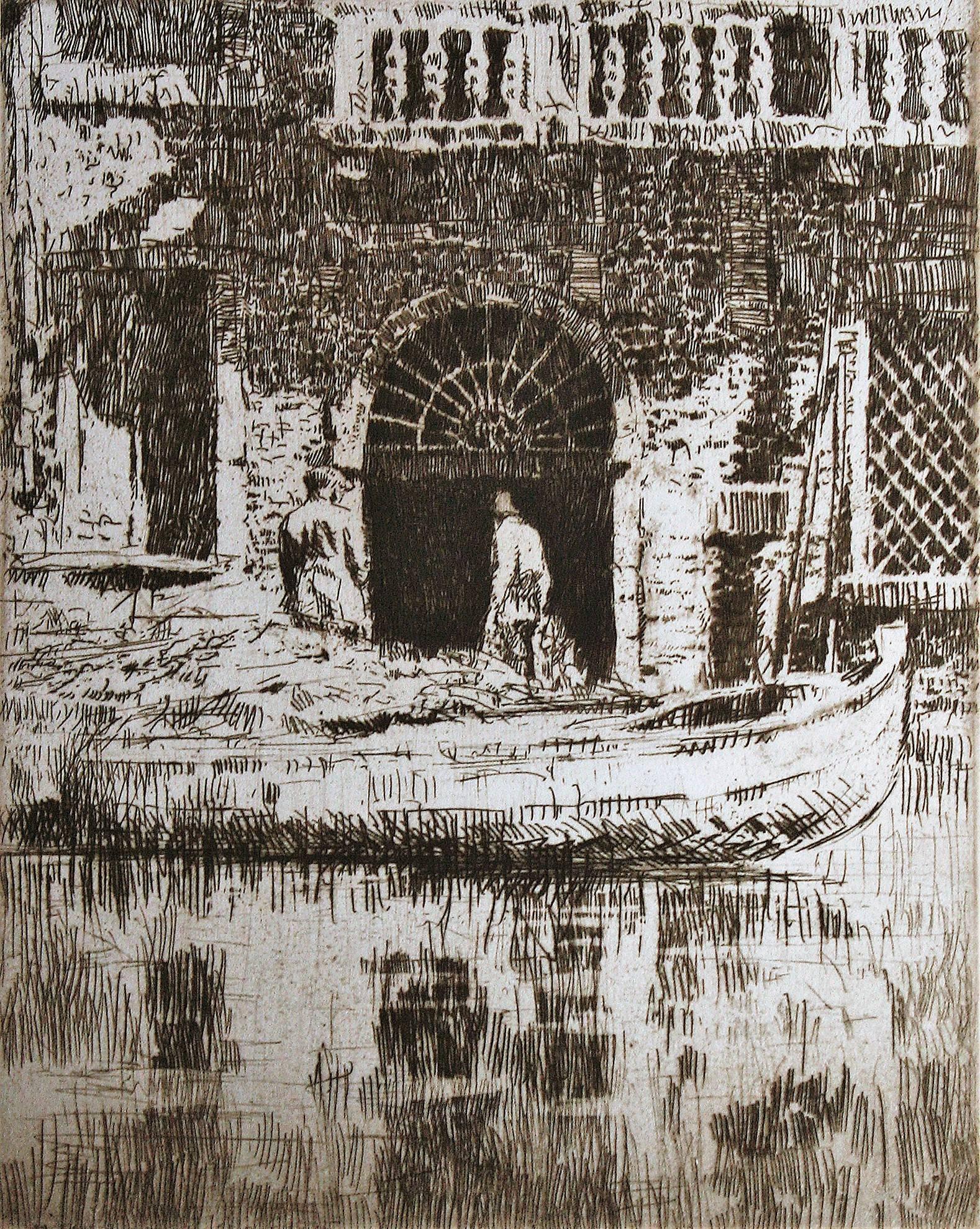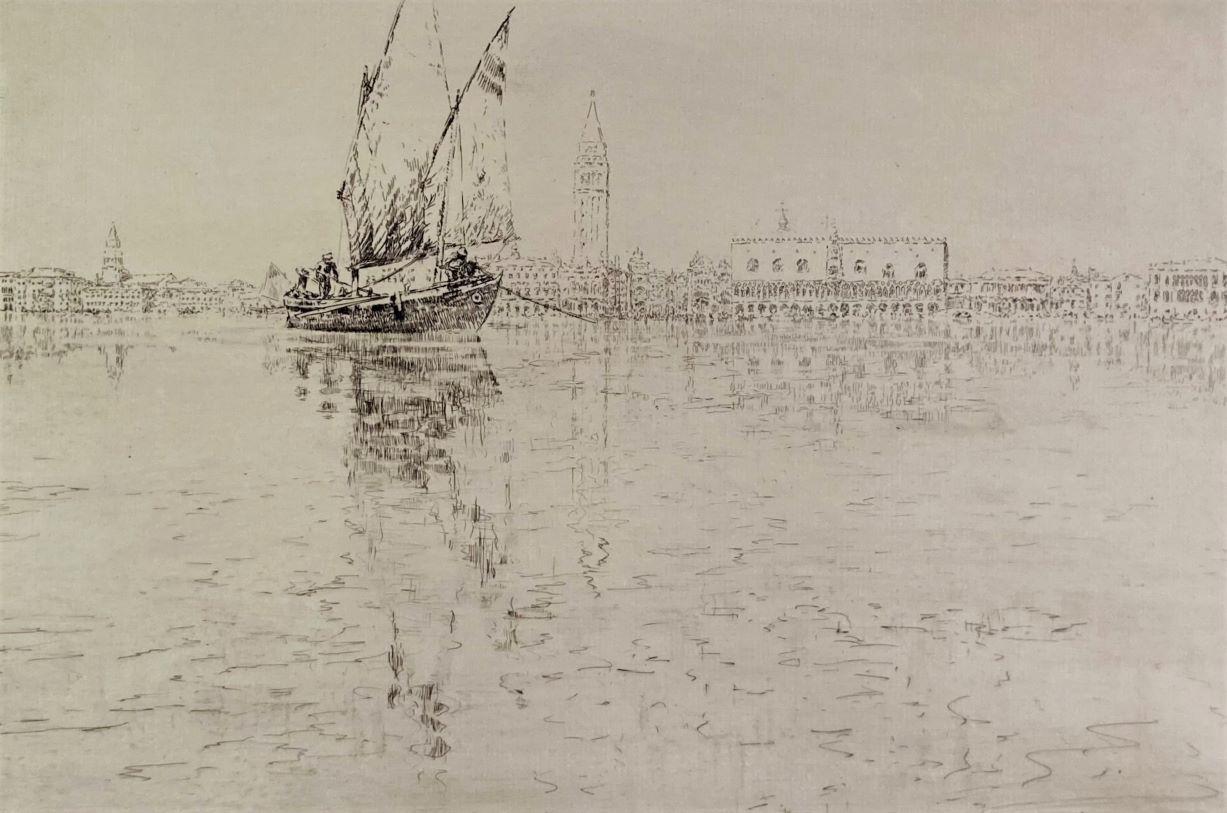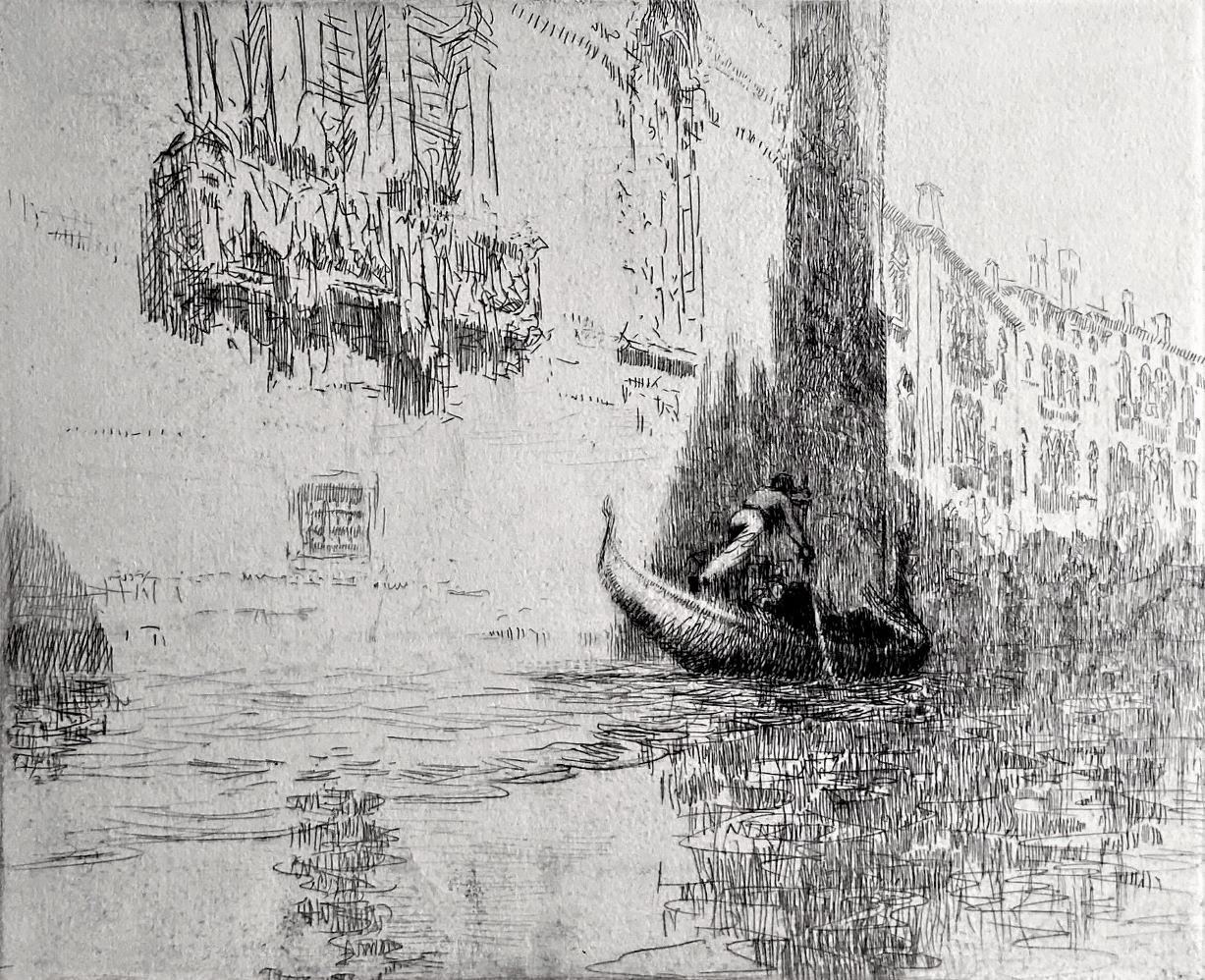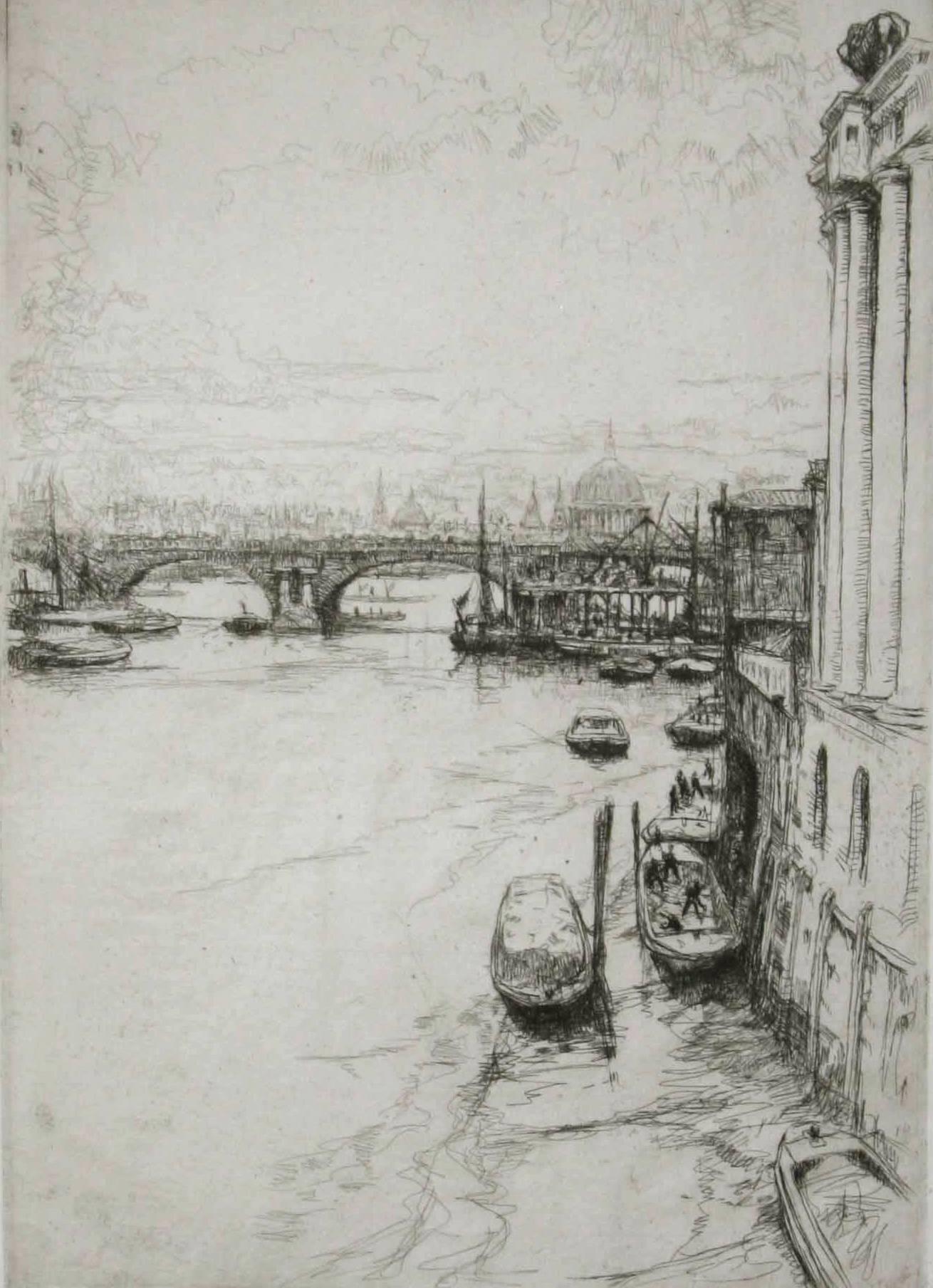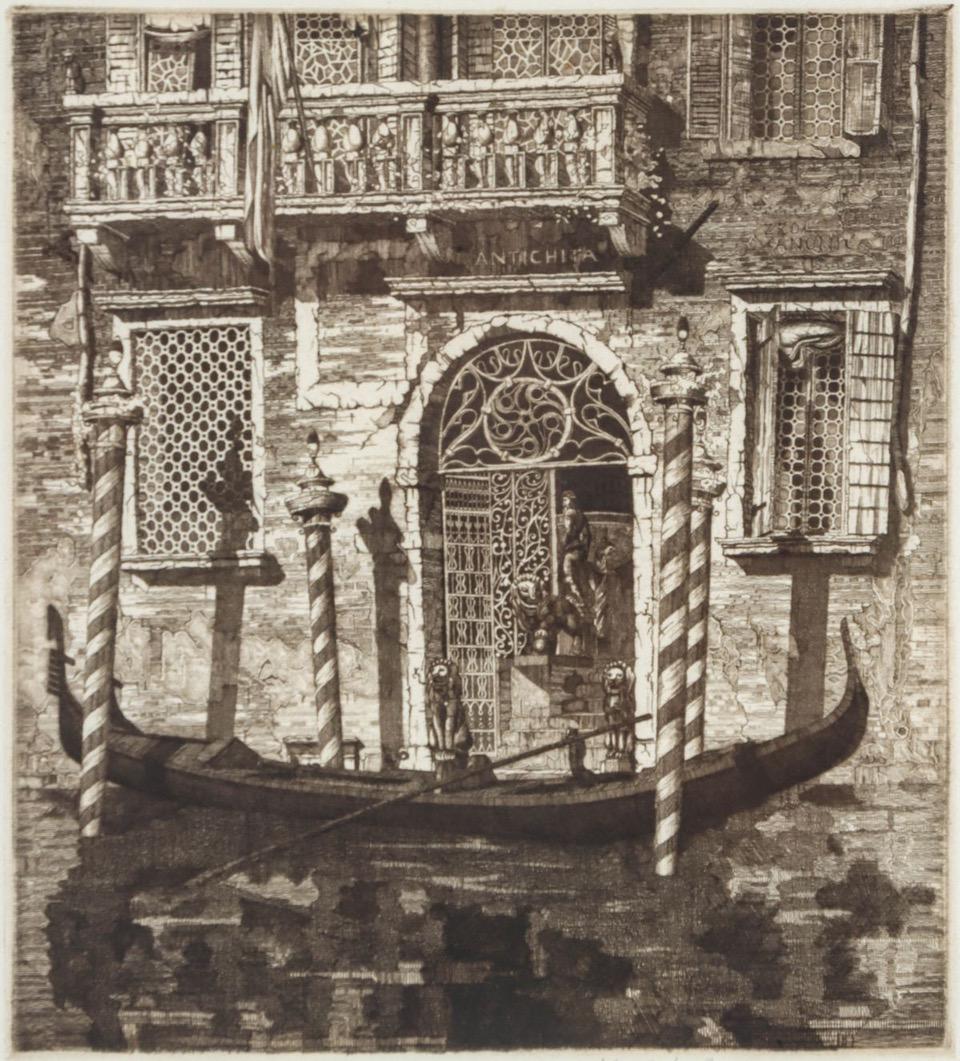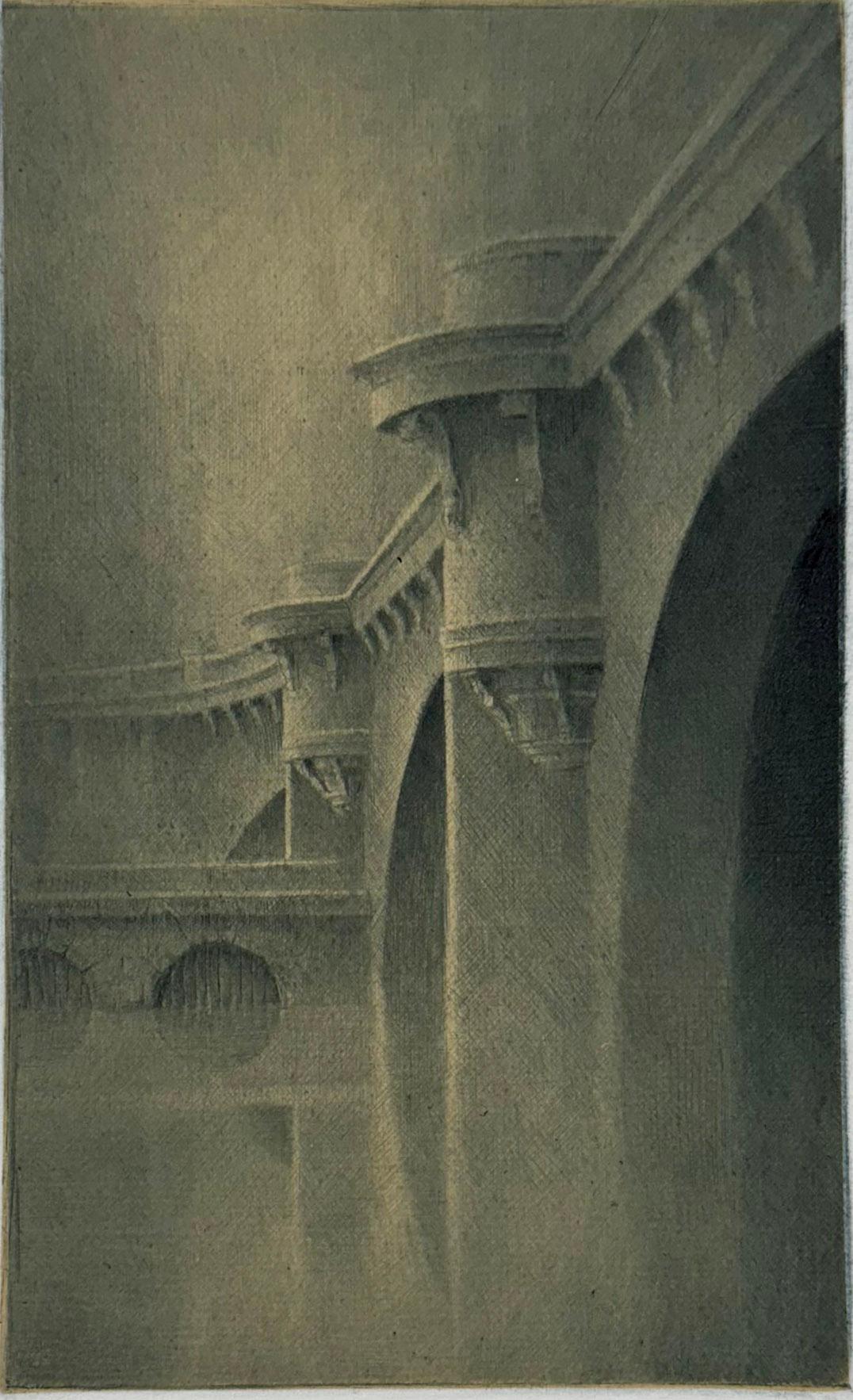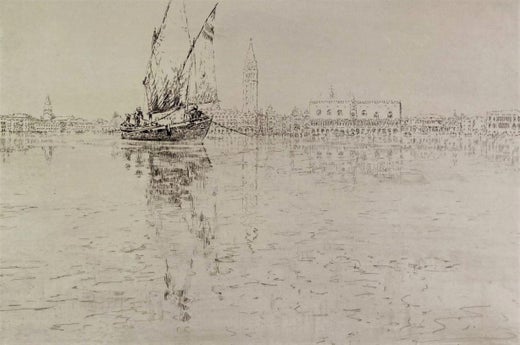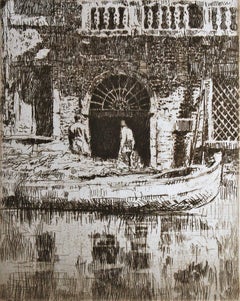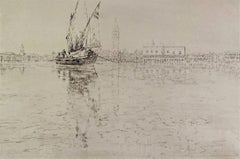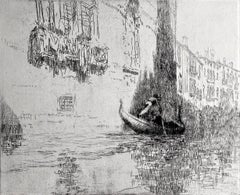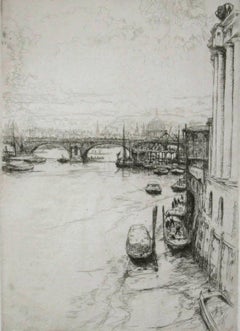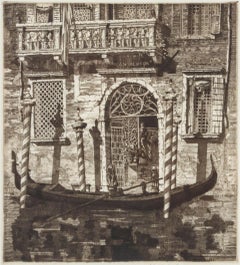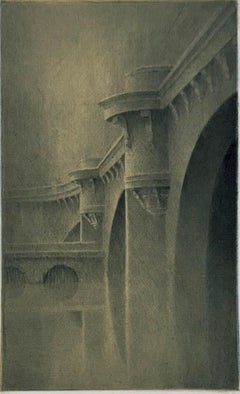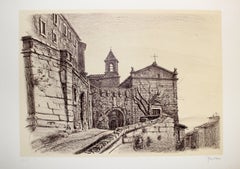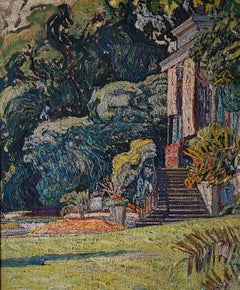Want more images or videos?
Request additional images or videos from the seller
1 of 6
James McBeyThe Deserted Palace.1938
1938
$1,800
$2,25020% Off
£1,392.23
£1,740.2820% Off
€1,584.97
€1,981.2120% Off
CA$2,584.51
CA$3,230.6420% Off
A$2,823.66
A$3,529.5720% Off
CHF 1,479.89
CHF 1,849.8620% Off
MX$33,715.35
MX$42,144.1920% Off
NOK 18,728.12
NOK 23,410.1520% Off
SEK 17,463.58
SEK 21,829.4820% Off
DKK 11,837.19
DKK 14,796.4820% Off
About the Item
The Deserted Palace. 1928. Etching. Hardie/Carter 236. 8 1/2 x 10 (sheet 10 1/2 x 12 3/8). Edition 80, #53. A rich impression printed in bistre ink with plate tone on antique French blue-green laid paper. Signed and numbered in ink. Housed in a 16 x 20-inch archival mat.
-------------------------------------------------------------------------------------------------------------
Carter writes, "the lower part of a Venetian palace, with crumbling walls of brick and plaster, is reflected in a canal. Under two barred windows is a man in a gondola, and another man stands upright on a landing-stage by a small door-way."
- Creator:James McBey (1883 - 1959, British)
- Creation Year:1938
- Dimensions:Height: 16 in (40.64 cm)Width: 20 in (50.8 cm)Depth: 0.5 in (1.27 cm)
- Medium:
- Movement & Style:
- Period:
- Condition:
- Gallery Location:Storrs, CT
- Reference Number:1stDibs: LU33521014773
James McBey
Born in Aberdeenshire, James McBey was a self-taught artist and etcher, best known for his prints, which coincided with an etching revival in the 20th century. After training himself in various techniques, in 1911 he gained an exhibition opportunity at the Goupil Gallery, London. From this point on his prints were published in London and Glasgow. During the First World War McBey was appointed official war artist to the Palestine Expeditionary Force. McBey's work is held in a variety of galleries across the UK and beyond, with Aberdeen Art Gallery holding the vast majority.
About the Seller
5.0
Recognized Seller
These prestigious sellers are industry leaders and represent the highest echelon for item quality and design.
Established in 1977
1stDibs seller since 2016
728 sales on 1stDibs
Typical response time: 12 hours
Associations
International Fine Print Dealers Association
- ShippingRetrieving quote...Shipping from: Storrs, CT
- Return Policy
More From This Seller
View AllThe Doorway.
By James McBey
Located in Storrs, CT
Hardie/Carter 244. 8 1/16 x 6 3/8 (sheet 10 1/4 x 8 1/4). Edition 80, #52. Illustrated: Guichard, British Etchers, 1850-1940; ; Eric Denker, Reflections & Undercurrents: Ernest Roth ...
Category
Early 20th Century Modern Landscape Prints
Materials
Drypoint, Etching
A Mirage
By James McBey
Located in Storrs, CT
A Mirage. 1928. Etching. Hardie 238. 11 13/16 x 14 3/8 (sheet 12 3/16 x 18 3/4). Edition 76, #46. Illustrated: Fine Prints of the Year, 1928 and 1938; Holmes, Etchings of Today. A ri...
Category
1920s Modern Landscape Prints
Materials
Drypoint, Etching
$1,750 Sale Price
30% Off
The Passing Gondola
By James McBey
Located in Storrs, CT
The Passing Gondola. c. 1926. Etching. Edition 80, #18. Hardie/Carter 230. 8 1/2 x 10 1/2 (sheet 11 1/4 x 13). Illustrated: Fine Prints of the Year, 1927. Printed on antique wove pap...
Category
1920s Modern Landscape Prints
Materials
Drypoint, Etching
$2,000 Sale Price
20% Off
Lion Brewery
By James McBey
Located in Storrs, CT
Lion Brewery. 1914. Etching. Hardie 149. 11 1/2 x 8 1/8 (sheet 13 5/8 x 10 1/8). Edition 50, #7. Illustrated: Salaman, Modern Masters of Etching. A fine impression of this scarce pri...
Category
1910s Modern Landscape Prints
Materials
Etching
Distant Salute (Venice)
By James McBey
Located in Storrs, CT
1925. Etching. Hardie/Carter 250. 7 x 15 (sheet 11 3/8 x 18 1/8). Edition 80, #28. Signed and numbered in ink. A fine impression with plate tone, printed on antique cream-colored wo...
Category
Early 20th Century Modern Landscape Prints
Materials
Etching
$1,250 Sale Price
24% Off
Make Fast, Plate 2.
By Arthur John Trevor Briscoe
Located in Storrs, CT
Make Fast, plate 2. 1929. Etching. Laver catalog number 146; Hurst catalog number 258. Plate: 14 3/8 x 9 13/16 (sheet 17 5/8 x 11 3/4). Trial proof 2, before the edition or 75. Ill...
Category
1920s Modern Landscape Prints
Materials
Drypoint, Etching
$1,800 Sale Price
20% Off
You May Also Like
Palazzo dell'Angelo
By John Taylor Arms
Located in Middletown, NY
Palazzo dell'Angelo
1931
Etching and drypoint on cream-colored, handmade laid paper with deckle edges, 7 1/4 x 6 3/4 inches (185 x 171 mm), edition of 100, full margins. Signed, dated and numbered "Ed. 100" in pencil, lower margin, second state (of three). Printed by Henry Carling, New York. Extremely minor mat tone and some inky residue in the top right corner, all unobtrusive and well outside of image area. An exquisite impression of this intricate image, with astonishing detail, and all the fine lines printing clearly. The image represents the first print which Arms printed on his own handmade paper. Framed handsomely with archival materials and museum grade glass in a wood gilt frame with a flower and garland motif.
Illustrated: Dorothy Noyes Arms, Hill Towns and Cities of Northern Italy, p. 180; Anderson, American Etchers Abroad 1880-1930; Eric Denker, Reflections & Undercurrents: Ernest Roth and Printmaking in Venice, 1900-1940, p. 116.
[Fletcher 233]
Born in 1887 in Washington DC, John Taylor Arms studied at Princeton University, and ultimately earned a degree in architecture at the Massachusetts Institute of Technology in 1912. With the outbreak of W.W.I, Arms served as an officer in the United States Navy, and it was during this time that he turned his focus to printmaking, having published his first etching in 1919. His first subjects were the Brooklyn Bridge, near the Navy Yard, and it was during his wartime travel that Arms created a series of extraordinarily detailed etchings based on Gothic cathedrals and churches he visited in France and Italy. He used what was available to him, namely sewing needles and a magnifying glass, to create the incredibly rich and fine detail that his etchings are known for. Upon his return to New York after the war, Arms enjoyed a successful career as a graphic artist, created a series of etchings of American cities, and published Handbook of Print Making and Print Makers (Macmillan, 1934). He served as President of the Society of American Graphic Artists, and in 1933, was made a full member of the National Academy of Design.
In its most modern incarnation, Palazzo dell'Angelo was constructed in or around 1570. The building, which has a rich and storied history, was erected upon the ruins of an earlier structure which predates the Gothic period. Some remnants of the earliest features of the residence were most certainly still visible when Arms visited, as they are today. Having a background in architecture, there's no question that Arms was moved by the beauty, history and ingenuity represented in the physical structure. One thing specifically gives away Arms's passion for the architecture, and that is the fact that he focused on the building's Moorish entranceway, balustrade, and two mullioned windows, and not on the curious Gothic era bas-relief of an angel nestled into the facade of the building, after which the structure is named. The sculpture itself doesn't appear in Arms's composition at all, despite the fact that it is the feature of the building that is most famous in its folklore. Arms instead focuses on the oldest portion of the architecture, even documenting some of the remnants of a fresco, and a funerary stele for the freedman Tito Mestrio Logismo, and his wife Mestria Sperata (visible above the water level, to the left of the door, behind the gondola), which was first described in 1436.
Among the many notable bits of history regarding the Palazzo, it has been documented that Tintoretto painted frescos of battle scenes on the facade of the building. The paintings have been lost to time and the elements, but not entirely to history. The empty frame...
Category
1930s American Modern Figurative Prints
Materials
Drypoint, Etching
Les Piler, by JMM Mathieux-Marie
By Jean Michel Mathieux-Marie
Located in Palm Springs, CA
Signed, titled and numbered, from the edition of 180. The base and parapets of a bridge.
Mathieux-Marie was born in Paris in 1947 and has been honored throughout his career with awa...
Category
1970s Contemporary Landscape Prints
Materials
Drypoint
Untitled Castle
Located in Kansas City, MO
Ferruccio Mataresi (1928 - 2009)
Untitled Castle
Lithograph
Year: Circa 60s
Signed and numbered by hand
Edition: L (50)
Size: 16.5 × 23.0 on 19.7 × 28.0 inches
COA provided
Ref.: 92...
Category
1960s Baroque Landscape Prints
Materials
Lithograph
$125 Sale Price
34% Off
Mansion
Located in Genève, GE
Work on canvas
Gray wooden frame
75.5 x 65 x 4 cm
Category
19th Century Landscape Paintings
Materials
Oil
$1,795
Evening - The depth of the visible -
Located in Berlin, DE
Max Clarenbach (1880 Neuss - Cologne 1952), Evening. Etching, 18 x 41 cm (platemark), 33.5 x 57 cm (frame), inscribed "Abend" in pencil at lower left, signed and dated "M. Clarenbach. 28.III.[19]09". Framed and mounted under glass.
- Somewhat browned and slightly foxed.
About the artwork
The horizontally elongated etching depicts the panoramic view of a small town as seen from the other side of the river. There are gabled houses on the left and a mighty church spire on the right. The bourgeois houses and the large religious building indicate the urban character. These buildings are rendered in dark tones to emphasise the lighter row of houses in the centre of the picture, closer to the water. The chiaroscuro contrast creates two parallel planes that open up a space for the imagination of what the city could be. The imagination is stimulated by the almost entirely dark, barely recognisable buildings, while the arm of the river leading into the city further stimulates the imagination.
However, as the silhouette of the city as a whole is reflected in the water, the parallel planes are perceived as a band of houses that stretches across the entire horizontality of the etching and seems to continue beyond the borders of the picture. The reflection has almost the same intensity as the houses themselves, so that the band of buildings merges with their reflection to form the dominant formal unit of the picture. Only the parallel horizontal hatching creates the convincing impression of seeing water, demonstrating Max Clarenbach's mastery of the etching needle.
The water is completely motionless, the reflection unclouded by the slightest movement of the waves, creating a symmetry within the formal unity of the cityscape and its reflection that goes beyond the motif of a mere cityscape. A pictorial order is established that integrates everything in the picture and has a metaphysical character as a structure of order that transcends the individual things. This pictorial order is not only relevant in the pictorial world, but the picture itself reveals the order of the reality it depicts. Revealing the metaphysical order of reality in the structures of its visibility is what drives Clarenbach as an artist and motivates him to return to the same circle of motifs.
The symmetry described is at the same time inherent an asymmetry that is a reflection on art: While the real cityscape is cut off at the top of the picture, two chimneys and above all the church tower are not visible, the reflection illustrates reality in its entirety. The reflection occupies a much larger space in the picture than reality itself. Since antiquity, art has been understood primarily as a reflection of reality, but here Clarenbach makes it clear that art is not a mere appearance, which can at best be a reflection of reality, but that art has the potential to reveal reality itself.
The revealed structure of order is by no means purely formalistic; it appears at the same time as the mood of the landscape. The picture is filled with an almost sacred silence. Nothing in the picture evokes a sound, and there is complete stillness. There are no people in Clarenbach's landscape paintings to bring action into the picture. Not even we ourselves are assigned a viewing position in the picture, so that we do not become thematic subjects of action. Clarenbach also refrains from depicting technical achievements. The absence of man and technology creates an atmosphere of timelessness. Even if the specific date proves that Clarenbach is depicting something that happened before his eyes, without the date we would not be able to say which decade, or even which century, we are in. The motionless stillness, then, does not result in time being frozen in the picture, but rather in a timeless eternity that is nevertheless, as the title "Abend" (evening), added by Clarenbach himself, makes clear, a phenomenon of transition. The landscape of the stalls is about to be completely plunged into darkness, the buildings behind it only faintly discernible. The slightly darkened state of the sheet is in keeping with this transitional quality, which also lends the scene a sepia quality that underlines its timelessness. And yet the depiction is tied to a very specific time. Clarenbach dates the picture to the evening of 28 March 1909, which does not refer to the making of the etching, but to the capture of the landscape's essence in the landscape itself.
If the real landscape is thus in a state of transition, and therefore something ephemeral, art reveals its true nature in that reality, subject to the flow of phenomena, is transferred to an eternal moment, subject to a supra-temporal structure of order - revealed by art. Despite this supratemporality, the picture also shows the harbingers of night as the coming darkening of the world, which gives the picture a deeply melancholy quality, enhanced by the browning of the leaf.
It is the philosophical content and the lyrical-melancholic effect of the graphic that give it its enchanting power. Once we are immersed in the image, it literally takes a jerk to disengage from it.
This etching, so characteristic of Max Clarenbach's art, is - not least because of its dimensions - a major work in his graphic oeuvre.
About the artist
Born into poverty and orphaned at an early age, the artistically gifted young Max Clarenbach was discovered by Andreas Achenbach and admitted to the Düsseldorf Art Academy at the age of 13.
"Completely penniless, I worked for an uncle in a cardboard factory in the evenings to pay for my studies.”
- Max Clarenbach
At the academy he studied under Arthur Kampf, among others, and in 1897 was accepted into Eugen Dücker...
Category
Early 1900s Realist Landscape Prints
Materials
Etching
$548 Sale Price
20% Off
Impressions of Italy - Italian Views
By Edgar Chahine
Located in London, GB
This complete set of fifty etchings, aquatints and drypoints are each hand signed by the artist "Edgar Chahine" at the lower left margins.
The folio was printed by A. Routy, Paris and published by Sagot, Paris in 1906.
The justification page is additionally hand signed in ink by the artist “Edgar Chahine” and the paper type is handwritten “Hollande”.
The impression is numbered in ink from the edition of 75 on the justification page. Each of the 50 plates are hand numbered in pencil to reflect their sequence and refers to the titles on the justification page.
Note: In 1906 the Fiancé of Chahine Mary Jacobsen died and the artist lost all love for life. His friend and publisher Sagot send him to Venice, Umbria and Toscana for distraction. Edgard Chahine returned with a sensitive group of etchings from the Italian countryside.
Literature: "Edgar Chahine: Catalogue de l'Oeuvre Grave", by M.R. Tabanelli, Published by IL Mercante de Stampe editeur, Milano, 1977.
Reference: Tabanelli 180-229.
Condition: Very good condition. The etchings, aquatints and drypoints in very good condition and printing with burr. The support pages and justification page with foxing staining. The folio cover...
Category
Early 1900s Landscape Prints
Materials
Drypoint, Etching, Aquatint
More Ways To Browse
George Washington Signed
Howard Behrens Giclee
Kiyoshi Woodcut
Lawrence Nelson Wilbur
Lithograph Prints Of Architecture
Merton College
Paris Etching Society
Phil Greenwood
Prints Claude Monet
Vlaminck Signed
Wu Guanzhong
Aaa Sign
Africa Maps By Emanuel Bowen
Alfredo Muller
Antique House Architectural Design
Antique Postcards 1900
Ashley Andrew
Auguste Delatre
